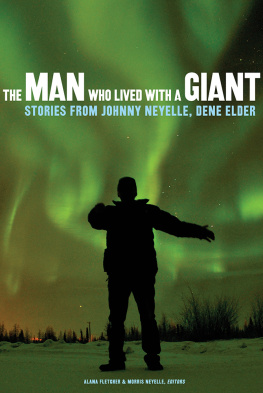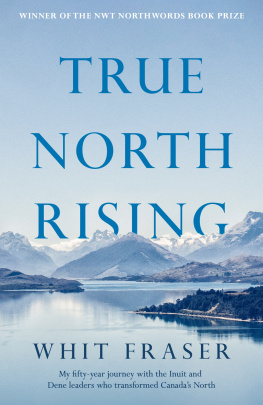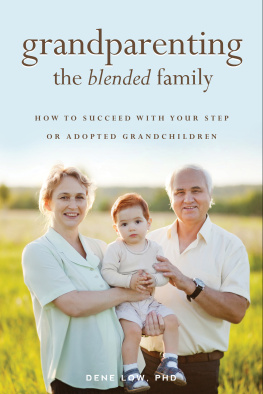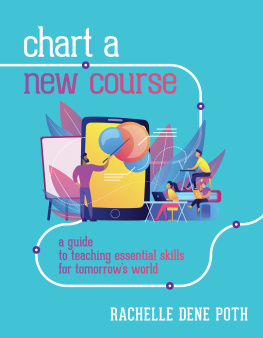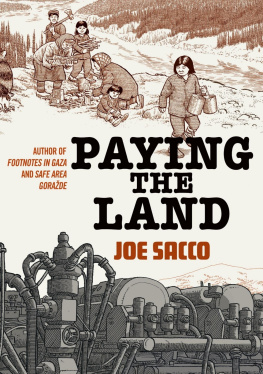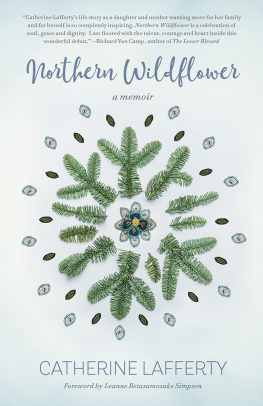Published by
The University of Alberta Press
Ring House 2
Edmonton, Alberta, Canada T6G 2E1
www.uap.ualberta.ca
Copyright 2019 The University of Alberta Press
LIBRARY AND ARCHIVES CANADA CATALOGUING IN PUBLICATION
Title: The man who lived with a giant : stories from Johnny Neyelle, Dene elder / Alana Fletcher and Morris Neyelle, editors.
Names: Fletcher, Alana, 1987 editor. | Neyelle, Morris, 1951 editor.
Identifiers: Canadiana (print) 20190057637 | Canadiana (ebook) 20190057718 | ISBN 9781772124088 (softcover) | ISBN 9781772124668 (EPUB) | ISBN 9781772124675 (Kindle) | ISBN 9781772124682 (PDF)
Subjects: LCSH: Chipewyan IndiansNorthwest TerritoriesFolklore. | LCSH: Chipewyan IndiansNorthwest TerritoriesHistory. | LCSH: Oral traditionNorthwest Territories.
Classification: LCC E99.C59 M36 2019 | DDC 398.2089/972dc23
First edition, rst printing, 2019.
First electronic edition, 2019.
Digital conversion by Transforma Pvt. Ltd.
Copyediting and proofreading by Kirsten Craven.
Book cover by Alan Brownoff.
Cover photo: Morris Neyelle. Used by permission.
All rights reserved. No part of this publication may be reproduced, stored in a retrieval system, or transmitted in any form or by any means (electronic, mechanical, photocopying, recording, or otherwise) without prior written consent. Contact University of Alberta Press for further details.
University of Alberta Press supports copyright. Copyright fuels creativity, encourages diverse voices, promotes free speech, and creates a vibrant culture. Thank you for buying an authorized edition of this book and for complying with the copyright laws by not reproducing, scanning, or distributing any part of it in any form without permission. You are supporting writers and allowing University of Alberta Press to continue to publish books for every reader.
University of Alberta Press gratefully acknowledges the support received for its publishing program from the Government of Canada, the Canada Council for the Arts, and the Government of Alberta through the Alberta Media Fund.

Contents
Preface
THIS BOOK, like any oral history collection, is the product of many important relationships: the relationship of the stories to all Sahtu Dene people, past and present; that of the storyteller and his son; the relationship of the two editors; and those among the editors and the support network that helped make this book a reality.
This book has been a long-time project, and its arrival has been eagerly anticipated by the Neyelle family and their whole community. It was in the 1980s that Morris first began recording Johnnys stories on cassette tapes with the goal of one day writing a book to share with his people. After his fathers death, Morris began the laborious process of transcribing and translating the recordings. When Alana, at that time a doctoral candidate studying the relationship between environmentalism and oral history, came to stay with Morriss family for fieldwork in Dline in 2014, Morris asked her to help him turn what he had done into a published book. Alana returned to Dline to stay with Morris in the summer of 2015, when he shared with her the transcriptions, family photos, and scans of Johnnys diary that he had collected.
Since that time, numerous phone calls, Facebook chats, emails, and ground packages have been exchanged between us as we built the collection that would become The Man Who Lived with a Giant: Stories from Johnny Neyelle, Dene Elder . The close relationship we were able to establish does not usually grow out of academic research by one party in the community of the other. Both of us are so grateful to each other for the trust, openness, and generosity shown on the one side and the transparency, humbleness, and responsibility maintained on the other. We very much appreciate each others hard work in taking on this opportunity to carry on Dene traditions in a good way.
We are very grateful to our families and our loved ones for their willingness to support and inform this project. All of our love and gratitude goes out to you, and you know who you are. We also want to say a big mhci cho to Danny Gaudet, Deb Simmons, Miggs Morris, and Lynda Lange for supporting our Northwest Territories Arts Council application. Mhci to the Arts Council for the funding it provided, and thank you to Peter Midgley, our anonymous readers, and the whole team at University of Alberta Press for knowing a good book when they saw it and pushing to make it the best it could be.
Johnny Neyelle and his storytelling deserve our greatest acknowledgements for inspiring this important book. Had he not developed his stories so masterfully and shared them so generously, this book would not be here today. We are also obligated to all the Dene people: to the ancestors who passed these stories on to us, and to the future generations to whom we pass them on. To all the communities of the Sahtu (Dline, Tulita, Khbamt, Rdeylk, and Teght), to all the people mentioned in these stories, and to Dene readers everywhere, mhci cho for letting us share and promote the Dene culture.
We hope this book will bring new understanding to many people in and beyond the Sahtu. Maybe it will be adopted in elementary and high school curricula in the Sahtu, in which capacity it could be readily available to young people, the most important audience for its stories. The stories in this collection offer much to non-Dene readers, as well, though it may not be readily apparent. As Johnny says, no matter who you are, where you are from, or what you think you need to know, if you grab hold of a story and put it in your heart, you will benefit from it in the future.
Introduction
FROM THE OUTSET, we wanted Johnny Neyelles words to remain the focus of this book, and the books structure reflects this. We have provided a short overview of the Sahtu Dene for readers who are not familiar with the peoples of the Northwest Territories. Following that, Morris briefly introduces his father and the reasons why a book like this is necessary. Then it is Johnnys turn to tell us a little about Dene philosophy and storytelling. These elements will provide readers with a sound framework with which to read Johnnys stories.
For those who are interested in exploring the scholarly underpinnings of the work, Alana has provided an afterword in which she talks about the methodology behind editing the stories. This is followed by a useful genealogy of the extended Neyelle family, and by a glossary of North Slavey words that appear in the text.
The Sahtu Dene
The Sahtotine, Sahtu Dene, or Bear Lake people are a traditionally nomadic group who historically moved throughout their territory following the resources available in different seasons. This territory occupies a large part of what is now Canadas Northwest Territories, bordered by and blending with the lands of the Kshogotine (Hare) and Shhtaotine (Mountain) Dene peoples. According to oral accounts, the Dene have occupied this area since time immemorial, and archaeological accounts show evidence of Dene habitation as far back as two to three thousand years ago.
The Sahtu are one of the Northern Athapaskan language groups, speaking a dialect called North Slavey. They have linguistic, spiritual, and political affinities with other Dene peoples, most immediately with other Northern Athapaskan speaking groups (Chipewyan, Ticho, Yellowknives, and Dehcho Dene) but also with Pacific Coast and Southern Athapaskan speakers in the continental United States (the Din and Ind, among others).
Johnny Neyelle, a respected Elder from the Sahtu Dene community of Dline, was known throughout the Sahtu and beyond as a gifted hunter, craftsman, and musician, but especially as a storyteller. These are his versions of some of the stories from his culture that pass on everything from hunting and trapping techniques to political and ethical frameworks to spiritual cosmologies through the generations.
Next page
